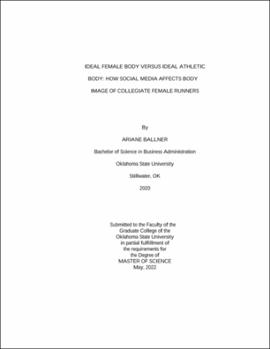| dc.contributor.advisor | McGuire, John | |
| dc.contributor.author | Ballner, Ariane | |
| dc.date.accessioned | 2023-04-03T20:51:37Z | |
| dc.date.available | 2023-04-03T20:51:37Z | |
| dc.date.issued | 2022-05 | |
| dc.identifier.uri | https://hdl.handle.net/11244/337232 | |
| dc.description.abstract | Female athletes are conflicted because they are pressured to conform to society’s ideal female body portrayed in the media and the ideal athletic body for their sport. In the sport of running, there is a huge emphasis on body weight, putting female distance runners at risk of developing body image concerns and disordered eating behaviors. Applying Fredrickson and Roberts’ objectification theory, this study aims to determine if the ideal female body portrayed in social media influences collegiate female runners’ body image perceptions and which ideal body type has a more significant impact on those athletes. Moreover, it investigates the significance of collegiate female runners’ athletic environments, including their coaches and teammates. | |
| dc.description.abstract | The researcher used non-probability sampling by recruiting 12 active collegiate female runners from several different U.S. States between 19 and 23 years old, with a mean of 21.83 years. To gain a deeper understanding of the conflict collegiate female runners experience, the researcher conducted in-depth interviews, including questions about social media, self-comparison, and participants’ athletic environments. Additionally, participants completed an online survey about their social media use, perfectionism and self-criticism levels, and demographics. Thematic analysis revealed that the ideal female body influenced most participants only in a social context. The ideal athletic body had a more significant impact on participants’ body image perceptions due to their identities as runners, performance pressures, and self-comparison with successful runners. Additionally, the athletic environment harmed most female runners’ body image perceptions and relationships to food caused by improper behaviors of their coaches and teammates. | |
| dc.description.abstract | These findings demonstrate the prevalence of negative body image and eating disorders among collegiate female runners. Moreover, this study illustrates the impact of those athletes’ physical and social media environments, influencing how they view and rate their bodies and what ideal body type they wish to conform to. Collegiate athletes must follow and surround themselves with people who make them feel positive about their bodies. Coaches must prioritize creating a healthy athletic environment and providing their athletes with professionals, including psychologists and registered dietitians. | |
| dc.format | application/pdf | |
| dc.language | en_US | |
| dc.rights | Copyright is held by the author who has granted the Oklahoma State University Library the non-exclusive right to share this material in its institutional repository. Contact Digital Library Services at lib-dls@okstate.edu or 405-744-9161 for the permission policy on the use, reproduction or distribution of this material. | |
| dc.title | Ideal female body versus ideal athletic body: How social media affects body image of collegiate female runners | |
| dc.contributor.committeeMember | McKinnon, Lori | |
| dc.contributor.committeeMember | Lewis, Bobbi Kay | |
| osu.filename | Ballner_okstate_0664M_17628.pdf | |
| osu.accesstype | Open Access | |
| dc.type.genre | Thesis | |
| dc.type.material | Text | |
| dc.subject.keywords | body image | |
| dc.subject.keywords | eating disorder | |
| dc.subject.keywords | female runners | |
| dc.subject.keywords | ideal athletic body | |
| dc.subject.keywords | ideal female body | |
| dc.subject.keywords | social media | |
| thesis.degree.discipline | Mass Communications | |
| thesis.degree.grantor | Oklahoma State University | |
